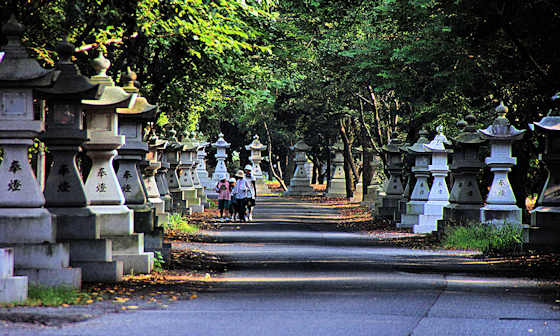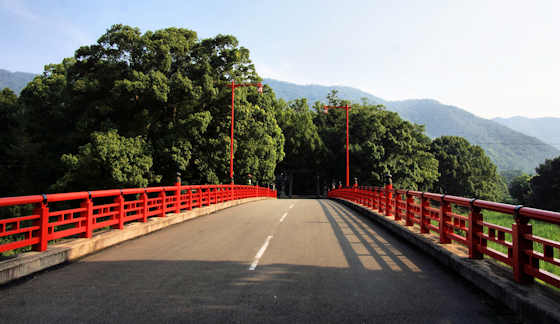Monday, December 12, 2011
Inside Kamo Culture Hall
Here are a few shots on the inside of the bizarre Kamo Culture Hall up in Kamo, Izumo.
It was opened in 1994 and was designed by Toyokazu Watanabe.
Unfortunately the auditorium itself was locked so I couldnt get any shots of it
Labels:
Architecture,
Izumo,
Kamo,
toyokazu watanabe
Saturday, December 10, 2011
Dainichi-ji Temple 4 Shikoku Pilgrimage
The architecture is nothing special, but in a covered corridor connecting the main hall with the Daishi hall are a collection of nice statues.
There is also a nice statue of Benzaiten.
EDIT..... When I first posted this my knowledge of Buddhist figures was very limited. The red statue is of course Binzaru, and I direct you to the excellent comment blow by Ted Taylor for details...
Friday, December 9, 2011
Benkei mask
I have finally got round to finishing some new masks. This one is of Benkei, the archetypal sohei (warrior monk) and famed sidekick of Yoshitsune. The dance he appears in is Tsuzuki Dannoura, which is based on a story in the Heike Monogatari. Popular in kabuki, it is an uncommon dance in the Iwami kagura repertoire, and it has been quite a few years since I have seen it performed.
Benkei is always depicted wearing a cowl and this signifies his status as a sohei.
More posts on Benkei can be found here
sk
More of my masks can be found here.
Labels:
benkei,
Iwami Kagura,
mask
Wednesday, December 7, 2011
Kanzui matsuri 3
The third dance at Kanzui's annual all-night matsuri was the first theatrical piece of the evening, Yumi Hachiman. The dance is very common and most matsuris will perform it. the first part of the dance sees Hachiman introduce himself and strut his stuff....
Hachiman, also read as Yahata, was originally a kami from northern Kyushu but grew in influence and became associated with the legendary Emperor Ojin. Eventually adopted as the tutelary deity of samurai he is known as the god of war. Hachiman shrines are now very common, and by one method of calulating are the most common shrines in Japan.
The second part of the dance sees the demon make his entrance, strut his stuff, and then hachiman and he begin their combat.
The second part of the dance sees the demon make his entrance, strut his stuff, and then hachiman and he begin their combat.
There are two versions of the demons identity, the first simply has him as a demon from a foreign country plaguing the local villagers in north Kyushu. The second has him as a demon from the lower levels of Buddhist hell. As much of the buddhist content was purged from Iwami Kagura in the late 19th century, It would suggest that tghis version is older.
Not surprisingly, the demon is defeated by Hachiman using a bow and arrows, weapons especially associated with Ojin.
The young junior-highschool boy dancing hachiman did a good job. In larger kagura groups hachiman has an aide.
Labels:
Hachiman,
Iwami Kagura,
kanzui,
Matsuri
Sunday, December 4, 2011
Art of Manidera
Saturday, December 3, 2011
On the henro trail
Sorry for the scarcity of posts recently. have been down in Shikoku on the henro trail.
Normal service will resume shortly
Labels:
iwaishima
Saturday, November 26, 2011
Oasahiko Shrine
Hemp was a very important plant in Japan until Shogun Macarthur outlawed it during the occupation.
Labels:
engi shiki,
hemp,
henro,
imbe,
sarutahiko,
shikoku,
Shrine,
tokushima
Monday, November 21, 2011
Cosplay
Well, this is something you probably thought you would never see on this blog, and it is something that surprises me too. Cosplay!
Last week I went up to Enchoen, a huge Chinese garden in Tottori, and when I walked in I was surprised to see lots of kids dressed up in cosplay. Apparently I had stumbled in to the 11th Annual Pan-Asian Cosplay Competition.
There were kids from China, Taiwan, Korea, Thailand, and of course Japan. They all had tons of high-end camera equipment and spent their time posing and shooting....
I dont read manga nor watch anime, so I have absolutely no idea who any of these characters are...
Saturday, November 19, 2011
Typical Japanese Landscape 30
Probably my favorite landscape views of Japan are from on high looking down on mist filled valleys.
All these shots are from dawn a couple of weeks ago up on Mt Hiba and Mt Eboshi, at around 1200 meters in the Chugoku Mountains stradding the border of Hiroshima and Shimane.
Someone wrote me and suggested I give more detailed info on the locations of my posts, so I have started to add google maps at the bottom of the posts. Is this helpful?
In actual fact, as is the case with much of life, the best Japan has to offer is not easily accessible.
View Larger Map
Thursday, November 17, 2011
Onbashi. The biggest natural bridge in Japan
Labels:
drainspotting,
hiroshima,
manhole
Subscribe to:
Posts (Atom)





































